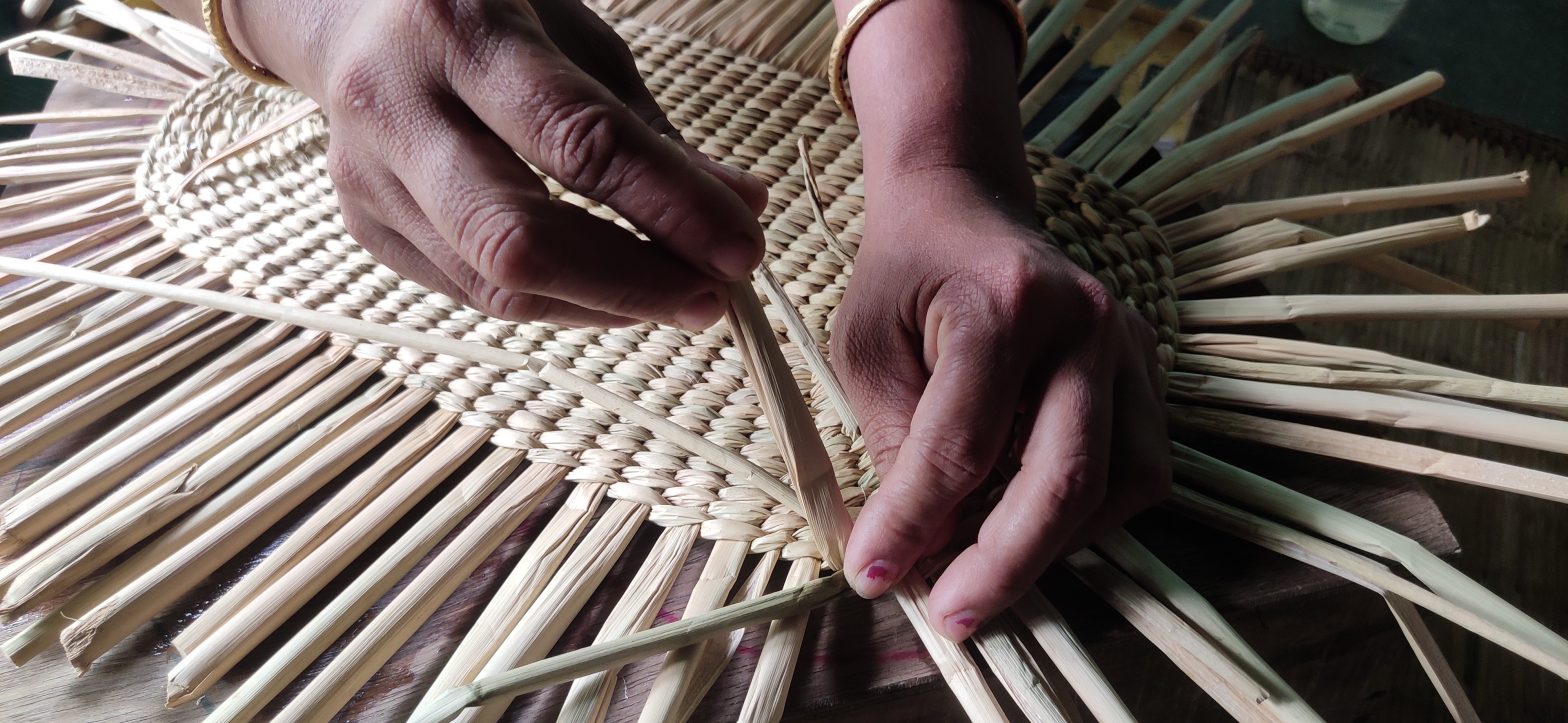
How Manipur’s rural women are weaving wonders from Kauna weed
Organic baskets, mats and other decorative handicrafts made of kauna grass grown in the marshes of the Imphal valley are providing a sustainable livelihood to women and their families.

Organic baskets, mats and other decorative handicrafts made of kauna grass grown in the marshes of the Imphal valley are providing a sustainable livelihood to women and their families.
M. Romita Devi crafts and sells popular products made of a weed that grows abundantly in the marshes and rice fields girdling her village in the north-eastern state of Manipur.
A what? A weed. But let’s not fault the autocorrect brain for mistaking the kauna grass for what the W-word means on the streets. This weed is just for weaving.

Endemic to the wetlands of Imphal valley, this perennial grass from the Cyperaceae family has long, cylindrical stems – and a soft, spongy texture that makes it tensile and easy to be woven into a variety of utility products such as baskets, hampers, hats, and mats. These products are biodegradable and hence, eco-friendly. But there’s more.
The grass supports a vibrant freshwater ecosystem, where farmers grow fish that they eat and also sell to supplement their income. Fresh stems make it to the wok too, relished for their sweet flavour.
Also Read | Agri-entrepreneurship: Inspiring family story in a cup of lemongrass tea
Kauna grass sits so close to the DNA of Manipur’s Meitei people that it‘s burrowed deep in their psyche and they don’t even think about it. But Romita, a mother of five, knows its significance in her life.
This grass is a blessing. People from far and wide come here to buy the grass we grow
L Promila Devi
So do about 2,000 other women in her village, Khangabok of Thoubal district, around 25 km from Imphal city, who are carrying forward a legacy—making handicraft items from kauna.
Romita and her farmer-husband rely heavily on the proceeds from her kauna products to feed and educate their daughter and four sons. Her daughter has cleared Class 12 and is prepping for college.
“I work eight hours a day to weave mats, baskets and decorative items from the grass. I earn around Rs 12,000 a month. Demand for kauna products has gone up recently,” she said.
Romita makes vanity bags, towel trays, picnic and laundry baskets, mats, and showpieces that often find pride of place in high-end hotels and plush homes in the cities and abroad.

Kauna products are known for their durability and water-resistant quality. “This grass is a blessing. People from far and wide come here to buy the grass we grow,” said artisan L. Promila Devi, 43.
The grass can be harvested thrice a year. It is cut near the base and sun-dried. In the wet season, these are smoked to make them last longer.
At the heart of kauna handicraft is women whose place in Meitei society has historically been high and who have contributed to its growth on an equal footing with men.
They still do. But no society has escaped the odd family friction, the occasional domestic discomfort, or the unfiltered in-law remark.
“Marriage brought me here a few years ago. My in-laws were a bit rude before I started making kauna items. I’m independent now. No more hissing, hemming and hawing. I take care of my children and their little expenses. My work has given me respect,” said a woman who doesn’t wish to be named.
The kauna craft and the growing demand for merchandise have checked the migration of men from poor families to urban centres for work.

Gunita Devi, a 42-year-old mother of two, makes around Rs 9,000 a month and her husband adds another Rs 10,000 to the family kitty doing menial jobs.
“We manage to run our family. We don’t have to go looking for work. I sell the Kauna products to middlemen and wholesalers. We also have a non-profit that helps us sell our items. Demand went up after our PM’s vocal-for-local initiative,” she said.
Also Read | Manipuri women revive village republics for all-round development
For some it is a side-hustle – a way to kill time in a gratifying and profitable way. “My husband is in the paramilitary and stays away for months. I use my time to do productive work and see to the expenses of my four children. I work in leisure and earn around Rs 8,000 a month,” said L. Sharmila Devi, 39.
The major role in marketing the traditional items outside their base is being played by the Organisation for Development of Economic and Self Help (ODESH), a non-profit working for the livelihood of the rural artisans.

“We’re trying to market the products throughout the country. We have dealers who sell them to wholesalers and retailers. We also attend fairs and exhibitions to create awareness about these items. We have sent the products to Dubai and Japan. Women are joining the business because of the income it brings,” said L. Kesho Singh, secretary of ODESH.
But challenges abound, such as a product’s price leaps manifold in a single bound before it reaches a customer because of mounting shipping costs.
Another worry confronts kauna – its very existence, in fact. Global warming and climate change have altered the region’s rainfall pattern, triggering drought-like situations in the region that has so much green that the colour hurts the eyes sometimes.
It won’t be for long. Kauna thrives in an aquatic environment. Long dry spells and erratic rain could be the end of a weed that weaves life.
Gurvinder Singh is a journalist based in Kolkata.